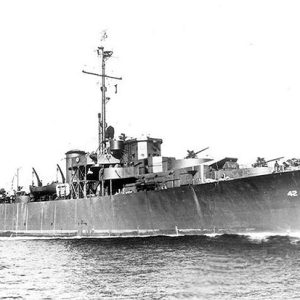calsfoundation@cals.org
USS Van Buren (PF-42)
The USS Van Buren was a Tacoma-class patrol frigate launched in 1944 that served in the New Guinea campaign in the western Pacific during World War II.
The USS Van Buren was the second U.S. naval vessel to bear that name. The first was an early nineteenth-century revenue cutter named for U.S. president Martin Van Buren. The World War II patrol frigate was named in honor of the city of Van Buren, the county seat of Crawford County.
The Van Buren’s hull was laid down on June 24, 1943, by Consolidated Steel Corporation in Los Angeles, California. The vessel was launched on July 27. It was commissioned at Terminal Island on December 17 under the command of Lieutenant Commander Charles B. Arrington of the U.S. Coast Guard.
The USS Van Buren weighed 1,430 tons, was 303 feet eleven inches long and 37.5 feet wide, and had a draft of thirteen feet and eight inches. It was armed with two three-inch fifty-caliber guns, two twin 40mm gun mounts, nine 20mm gun mounts, and nine depth-charge projectors, including one hedgehog. The Van Buren was powered by two 5,500-horsepower J. Hendy Ironworks engines that enabled it to reach speeds of 20.3 knots.
The Van Buren had its shakedown cruise (a test of the ship’s performance) off the West Coast and sailed for the western Pacific from San Pedro, California, on March 9, 1944, reaching Mime Bay, New Guinea, on April 2. U.S. forces invaded New Guinea on April 21, 1944, and the Van Buren escorted convoys into the area through May and June, supporting operations at Hollandia, Wake Island, and Biak Island. The vessel was called on to support army operations several times in June, the first time on June 9, when Van Buren shelled clusters of Japanese troops. It performed similar support on June 19 and, on June 20, fired 150 rounds from its three-inch guns and 180 40mm rounds; it fired with direction from an army spotter plane. It was called into action again on June 23, breaking up troop concentrations and destroying communications and supplies.
In August, the USS Van Buren screened navy ships operating at Cape Sansapor and performed escort duties into the fall. At some point, it was accidentally struck by a Liberty ship while at anchor in Humboldt Bay, suffering damage to its fantail that was repaired in the harbor. On November 16, the Van Buren broke away from a convoy to rescue the crew of a downed army aircraft. The ship performed convoy and screening duties with the Seventh Amphibious Force in the Philippines into late 1944.
On January 2, 1945, the Van Buren sailed into Pearl Harbor to operate as a training ship with the destroyer force there, performing those duties through the spring. Ordered back to the United States, the Van Buren reached San Francisco, California, on July 2, where it was fitted out as a weather ship. The vessel fulfilled those duties into 1946 but was ordered to leave San Francisco on March 13.
The Van Buren arrived in Charleston, South Carolina, on April 3 and was decommissioned on May 6. Struck from the navy list on June 19, the USS Van Buren was sold to Sun Shipbuilding and Drydock Company of Chester, Pennsylvania, for scrap in August 1947.
The USS Van Buren earned three battle stars during World War II.
For additional information:
Hendrickson, David H. The Patrol Frigate Story: The Tacoma-class Frigates in World War II and Korea, 1943–1953. Columbia, MD: Fortis, 2011.
“Van Buren (PF-42).” Dictionary of American Naval Fighting Ships. http://www.hazegray.org/danfs/patrol/pf42.htm (accessed June 13, 2018).
Mark K. Christ
Little Rock, Arkansas
 Military
Military World War II through the Faubus Era, 1941 through 1967
World War II through the Faubus Era, 1941 through 1967 USS Van Buren
USS Van Buren 




Comments
No comments on this entry yet.